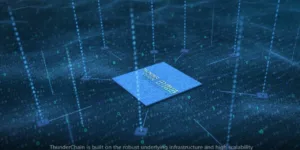The news that Facebook’s cryptocurrency Libra could be put on hold has drawn global attention.
Mike Crapo, chairman of the U.S. Senate Committee on Banking, Housing and Urban Affairs, raised concerns about the regulatory compliance of digital currencies like Libra in the U.S. and many other jurisdictions in terms of data privacy protection, as well as about major security issues caused by Libra’s potential for being abused by money launderers and terrorist financiers. The former is particularly significant, given Facebook’s massive data breaches earlier.
While the Libra project has ground to a halt, the competition in the blockchain sphere is inevitable. “If we don’t lead in blockchain technology, China or someone else will”, said Senator Catherine Cortez Masto.
This fear has proved to be well justified.
On July 30, Onething Technologies, a subsidiary of China-based cloud computing and blockchain giant Xunlei Limited, announced the progress of one latest blockchain technology – a traceable privacy protection solution developed by its high-performance blockchain platform ThunderChain, which allows multi-level permissions to meet both privacy and traceability requirements and ensures both data protection and regulation.
This is a problem that has plagued many blockchain applications such as Libra. How did ThunderChain overcome it?
According to Lai Xin, ThunderChain’s chief engineer, this technology has credible, decentralized network architecture; meanwhile, it encrypts and hides data by encryption algorithms such as ring signature and zero-knowledge proof to protect user privacy. In addition, a cryptographic approach is used for risk mitigation at the maximum and protection of users’ lawful rights to meet the needs of organizations or faculties with information control authority.
For real-world applications of the blockchain technology, users are often concerned about their personal data in relation to transaction and identity, etc. being seen in clear text; as data exchanges increase, the relevance of blockchain will result in, more or less, revealing of personal privacy. For example, transactions between two or more parties may create a statistics-based data structure as a record of blocks of transactions, and any part of the transaction data may lead to the leakage of more sensitive information.
ThunderChain provides homomorphic encryption to protect original privacy data in the form of ciphertext. Meanwhile, validator nodes can use zero-knowledge proof for ciphertext verification to ensure the account balance is greater than or equal to the amount being transferred. The transaction will be successfully processed after the completion of validating steps without revealing transaction details. When needs for validating data scope, etc. are involved, zero-knowledge proof can be used to ensure data are valid without revealing sensitive information, so that data privacy can be better protected.
Take the property ownership and transaction system as an example. It is a scenario with unique demands for privacy protection and information control measures. The property information is encrypted and stored in the chain and transactions are processed in a manner of privacy protection. Meanwhile, real estate authorities may oversee buying and selling of property using cryptographic technologies and review suspicious and illegal information using ThunderChain’s traceable privacy protection solution.
As a technology innovation, this solution is designed not only to fully protect user privacy but also to provide technical feasibility for data management and address the challenges to the protection of sensitive information for blockchain applications in government, healthcare, finance, and other sectors. With this technology, many issues facing Libra could be solved.
Security is the key to blockchain implementation
In addition to privacy protection, the overall security of blockchain networks needs to be improved.
Security vulnerabilities are the key factor affecting the growth of the blockchain ecosystem. Since 2018, there has been a surge of security incidents in the blockchain industry. Main chains including EOS and Ethereum have reported security breaches more than once, causing huge losses. According to the blockchain security company PeckShield, 2018 saw 138 blockchain security incidents, with a great economic loss of $2.238bn.
In particular, with the rise of smart contracts and DApps, developers may bring about a wide array of security risks, posing serious threats and challenges to the blockchain ecosystem, which will, in turn, stand in the way of wider and in-depth adoption of blockchain.
It is clear that Chinese blockchain companies are leading the way in blockchain security technologies. As a leading blockchain platform in China, ThunderChain has achieved a number of technological innovations for blockchain security.
An example is the cryptographic commitment solution featuring commitment-based smart contracts to protect the decision-making privacy of participants and ensure fairness and participation, which will, in turn, give rise to the design and implementation of more complex privacy protection scenarios.
In addition to high-performance features, ThunderChain has created a multi-level security scheme for all layers, i.e. Application, Contract, Consensus, Data, and Network, to provide omni bearing security guarantee from the perspective of technology.
For the Application layer, hardware-based security solutions are supported, including clipper chip and TEE-based private key, etc. For the Contract layer, contracts are subject to a well-established contract approval process that features an emergency response plan and allows quick exit when security threats are detected without affecting other contract services. For the Consensus layer, DPOA + PBFT algorithms are used to identify high-performing nodes from the candidate pool to generate blocks in a PBFT mechanism. For the Data layer, a hierarchical approach to managing nodes and data is adopted with the freezing and unfreezing process for accounts found in violation. For the Network layer, network security, firewall configuration, and other services are available and cryptographic algorithms approved by the Office of the State Commercial Cryptography Administration (“OSCCA”) are supported, including commercial cryptography methods such as asymmetric algorithm SM2, cryptographic hash algorithm SM3, and symmetric algorithm SM4.
All these are contributing to wide and in-depth adoption of the blockchain technology.
In fact, this is not the first time ThunderChain has tackled a technological headache. ThunderChain ushered in the era of Blockchain 3.0 with the capabilities to handle millions of transactions per second (TPS) and realize confirmation in seconds. High technological threshold and poor product experience are the other two main concerns in blockchain apps development, besides performance. ThunderChain has made it easy and simple for developers to launch blockchain-based products and services by optimizing the development environment and improving product experience. ThunderChain provides Catalyst development tools for EVM and WASM and supports multiple programming languages such as C/C++ and Solidity, reducing greatly technological complexity and facilitating blockchain implementation. Now, ThunderChain has implemented a variety of business scenarios in public welfare, healthcare, education, social network, transportation, authenticity verification, and copyright, etc. As one of the most commonly used underlying blockchain systems, ThunderChain is a blockchain solution partner to the Copyright Protection Center of China, South New Media, and One Foundation, etc.
The Copyright Protection Center of China has worked with a number of content platforms to introduce Digital Copyright Identifier (DCI), a ThunderChain-based system for copyright services. DCI assigns permanent identifiers and issues digital copyright certificates to digital works on the Internet, and creates a reliable and verifiable certification system using e-signature and digital certification to solve fundamentally piracy and infringement issues in the field of digital copyright.
As we are seeing, leading companies such as Onething Technologies are working on innovative technologies to promote the wider adoption of blockchain. Blockchain-based innovations will reshape our society and provide an opportunity for China to outrun Western countries.








